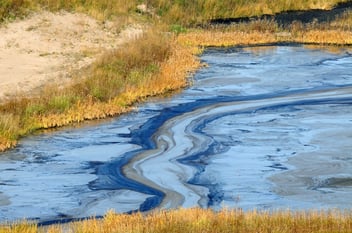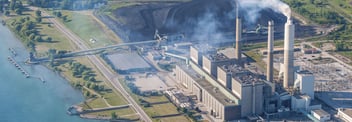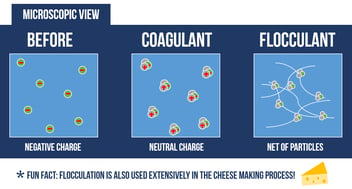Sustainable Water Treatment: What Does that Really Mean?
When we think about sustainability, sustainable water treatment might rank near the top of the list in terms of sustainability efforts. After all, water is our planet's most precious resource.
Without it, life would not be able to exist. 
That's why promoting sustainability in water treatment is a no-brainer.
With that said, change doesn't happen overnight. Just like any other industry, shifting to more sustainable chemicals and processes takes time.
However, the first step in getting the ball rolling is spreading the word about sustainable water treatment: What is it? How can it help your business and the environment?
In this article, we'll dive into the basics of sustainable water treatment so you can start thinking about how it might work for your water treatment needs and, in turn, for the needs of our world. While not everything in this article will apply to your application, we hope this is a good starting point to start thinking about the way your plant operates (maybe it will even inspire you to do an LCA ... more on that later).
What Is Sustainable Water Treatment?
“Sustainable water treatment” refers to water purification and wastewater management approaches that, in a nutshell, minimize environmental impact from various water treatment facilities. Whether it's stormwater, industrial, cooling towers, or something else, treated water requires chemicals combined with other strategies, like filtration technology.
So, if we break sustainable water treatment down into a cluster of ideas, here's what it comes down to:
-
Energy efficiency and renewable energy: This goes for just about any type of operation, but energy efficiency can be a key driver of sustainable water treatment. Think about the water treatment process from end to end. If the energy that is powering your process comes from a more sustainable source (e.g., renewables), then your entire process becomes more sustainable.
-
Water reuse / recycling: Instead of discharging treated water, reuse it (non-potable or potable) to reduce demand on freshwater sources. Given increasing global concerns about water scarcity, it's important to adopt a "no or minimal waste" philosophy. Think about your daily lives and how you might hold onto a particular consumer good, even if it's not in perfect condition, because to discard it in favor of a new item would simply be adding waste to our ever-growing landfills.
-
Reduced chemical use / safer chemicals, and minimizing sludge/waste/effluent toxicity. As with everything else we do, water treaters have to think about the impact water treatment processes have on the surrounding environment. Humans and wildlife alike depend on clean sources of water, and ineffective or inefficient water treatment can have a significant domino effect across ecosystems. This is what Dober prides itself in, particularly in the form of the use of chitosan for nature-based treatment products that break down naturally. Additionally, the use of biopolymers for a wide variety of applications, from industrial to agricultural, has also grown in recent years.
-
Nature-based or hybrid solutions, e.g. constructed wetlands. In some applications, constructed wetlands represent a creative and nature-based solution for water treatment. Constructed wetlands "use natural processes involving wetland vegetation, soils, and their associated microbial assemblages to improve water quality," the EPA notes. While this might not be a solution that's feasible for everyone, think of it as a potential tool in your toolbox.
-
Lifecycle thinking: Following from the earlier point, it's easy focus on the end product of water treatment and the chemicals used to get to that point. However, sustainable water treatment is more than just those things: water treatment operations should consider bolstering the sustainability of their entire process from A to Z. Every part of an operation plays a role and falls somewhere on the sustainability spectrum: the more things that fall on the more sustainable side of the spectrum, the better. For water treaters, life cycle assessments (LCAs) are a key tool by which they can see the big picture when it comes to sustainability of their operation (Corominas et al).
Examples of Sustainable Water Treatment
Here are several real-world or near-real-world examples illustrating what sustainable water treatment looks like in practice:
Constructed Wetlands / Nature-Based Treatment
As mentioned previously, constructed wetlands use vegetation, soils, and microbial communities to treat wastewater (greywater, stormwater, industrial, municipal). These systems can treat organic loads, nutrients, and sediments with minimal energy input and lower ongoing costs relative to conventional mechanical systems.
Hybrid Renewable Energy + Wastewater Treatment
Some wastewater treatment plants are integrating renewable energy sources (solar, biogas, heat recovery) to power operations. For example, in Eskişehir Industrial Zone (Turkey) a plant of capacity ~24,000 m³/day considered renewable energy integration to offset its large energy demand (~700,000 kWh+).
Water Reuse / Onsite Reuse
Non-potable reuse systems in buildings or districts. A good example is the Domino District Non-Potable Water Reuse Project in Brooklyn, New York: the system treats ~400,000 gallons/day (≈1,500,000 liters/day) of wastewater from five new buildings, and reuses it onsite for toilet flushing, cooling tower makeup, irrigation, etc. This reduces potable water demand significantly. (US EPA)
Energy Efficiency & Emission Reductions via Process Upgrades
A study of surface water treatment plants showed that using membrane filtration could reduce energy use by up to ~50%, and using biogas from sludge treatment could lower external energy demand by 15-25%. This leads in many cases to CO₂ emissions reductions of ~10-20% compared to conventional methods.
Graywater Recycling in Buildings
A case study in Los Angeles (single-family and multifamily homes) found that onsite graywater recycling reduced potable water demand by ~27% in single-family homes and ~38% in multifamily homes.
ROI of Sustainable Water Treatment
Implementing sustainable water treatment often requires upfront investment (capital cost, design, permitting, sometimes higher technology or materials).
With that said, many things in life that require work on the front end often yield long-term benefits.
The same can be said for sustainable water treatment.
Here's why sustainable water treatment doesn't have to be a cost center for your operation -- if anything, it can be a financial boon in the long run:
Key Sources of ROI
-
Reduced water supply and sewer fees: Less fresh water bought; less effluent discharged, possibly shrinking fees.
-
Lower energy costs: Through efficiency, renewable energy, energy recovery.
-
Regulatory compliance / avoiding fines: Stricter regulations around water discharge, quality, water scarcity.
-
Resilience and risk management: Less dependency on municipal supply, better handling of droughts/climate change.
-
Incentives, grants, tax breaks: Many local or state governments encourage sustainable water reuse, green infrastructure, etc.
-
Branding/market differentiation: In many industries, being able to claim "green" bona fides can be a brand booster.
5 Steps to Implement More Sustainable Water Treatment
The first step is determining you want to drive more sustainable water treatment operations.
What comes next?
Below is a basic playbook to move your operation closer to the goal of sustainable water treatment operations:
Assess baseline water & energy use, costs, risks
- Audit how much water is used, where losses occur, what effluent is being discharged.
- Map energy consumption across treatment steps (pumps, aeration, disinfection, sludge handling, etc.).
- Identify regulatory obligations, potential penalties, incentives.
- Understand climate risks: supply variability, droughts, storms.
Set clear goals and metrics
- Define what “sustainability” means for your context (e.g., percent reduction in potable water, energy intensity, emissions, cost).
- Choose KPIs, including water reuse rate (%), energy consumed per cubic metre treated, CO₂ emissions, cost payback period, etc.
- Include social/environmental metrics where relevant.
Evaluate treatment technologies and system design
-
Consider technologies that are more efficient: membrane filtration, UV/LED disinfection, energy‐recovering pumps, biogas from sludge.
-
If feasible, Explore nature-based or hybrid solutions: wetlands, constructed wetlands, biofilters.
-
Decide between centralized vs decentralized systems depending on geography, population density, demand patterns.
Financial planning and securing funding
-
Estimate total capital & operating costs, then project savings over time. Build business case including incentives/grants.
-
Explore financing models: public-private partnerships, performance contracts, utility-led programs.
-
Factor in non-monetary but real benefits (resilience, regulatory risk reduction, branding, market differentiation).
Monitor, iterate, engage stakeholders
- Set up monitoring: water quality, energy use, emissions, maintenance costs.
- Use data to refine processes, fix inefficiencies, update technologies.
- Engage community/public to address social acceptance (especially for reuse or recycled water).
- Work with regulators to comply with standards.
Sustainable Water Treatment Resources
We always encourage professionals working in the industries we serve to always seek knowledge, whether it's here on our website or other reputable sources.
If you're a water treater who wants to learn more about all facets of sustainable water treatment, Here are some resources for deeper learning, case studies, tools and more:
-
United Nations Sustainable Development Goal 6 (Clean Water and Sanitation) — provides global targets and indicators.
-
U.S. EPA’s Water Reuse Case Studies — real projects showing benefits and trade-offs.
-
Research articles in scientific journals, like MDPI, on energy efficiency in water treatment plants
-
Local/state incentive programs — many governments and utilities provide rebates, grants, or regulatory incentives for reuse, green infrastructure, efficiency.
IN Summary ... Sustainable water treatment can mean a lot of things
Sustainable water treatment is so much more than just cleaning water.
Like the concept of sustainability as a whole, there's a lot that goes into it. In short, it's about minimizing environmental footprint, optimizing energy use, reuse of water, and financial as well as social viability, among other things.
Real-world examples—from water reuse in buildings to energy savings in treatment plants—show that sustainable approaches can reduce costs, cut emissions, and help organizations manage risk.
While initial costs and regulatory hurdles can be barriers, with good baseline assessments, clear goals, proper technology selection, smart financial planning, and ongoing monitoring, the ROI of sustainable water treatment can be substantial.
As water scarcity, climate pressures, and regulatory demands increase, shifting toward sustainable treatment is not a nice-to-have but a strategic imperative.
Interested in continuing the conversation about sustainable water treatment? Reach out and we'll be happy to share more about how we can help make your water treatment process more sustainable.
REFERENCES
1. Lluís Corominas, Diana M. Byrne, Jeremy S. Guest, Almudena Hospido, Philippe Roux, Andrew Shaw, Michael D. Short, The application of life cycle assessment (LCA) to wastewater treatment: A best practice guide and critical review, Water Research, Volume 184, 2020, 116058, ISSN 0043-1354, https://doi.org/10.1016/j.watres.2020.116058 (https://www.sciencedirect.com/science/article/pii/S0043135420305959).





